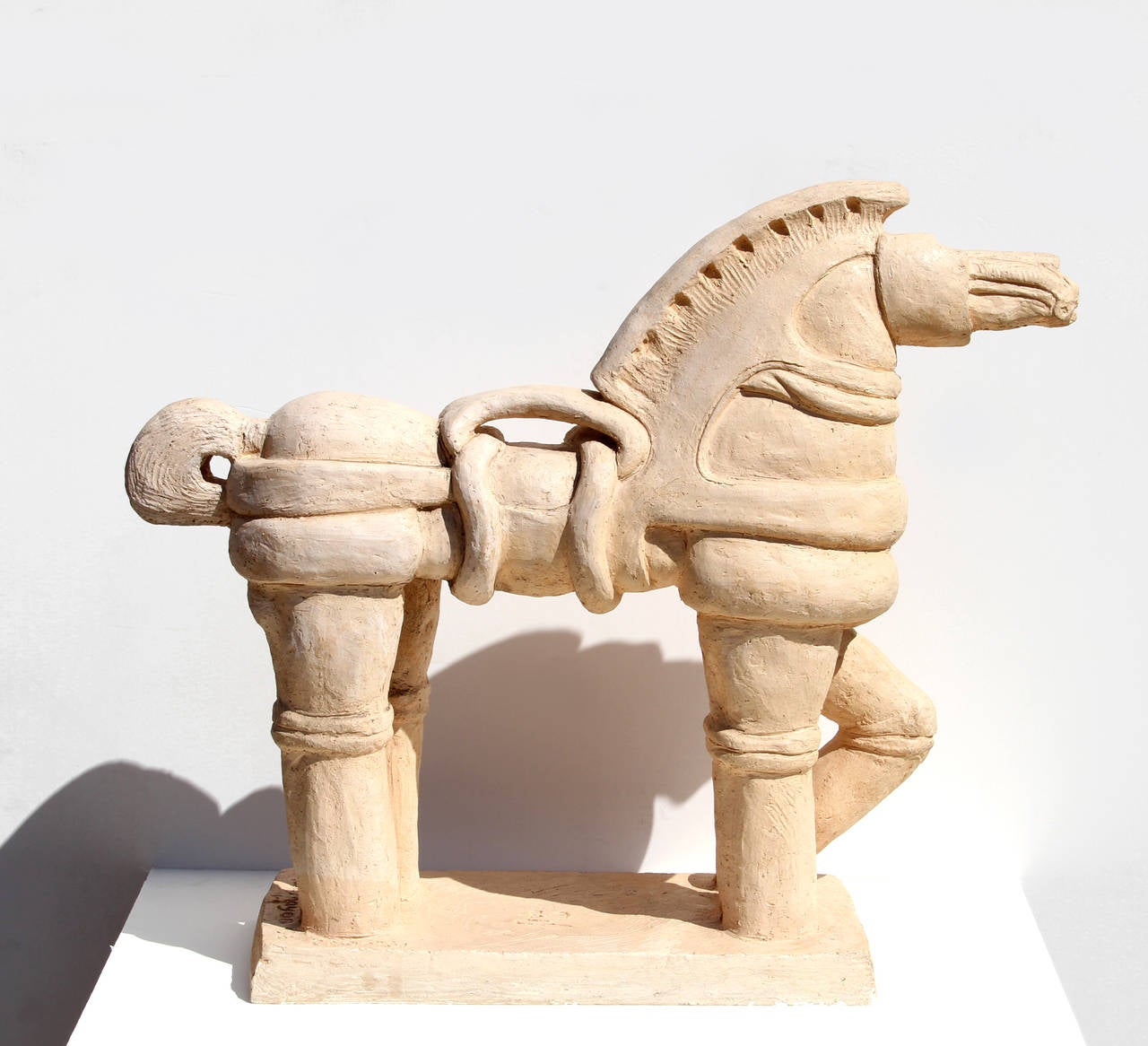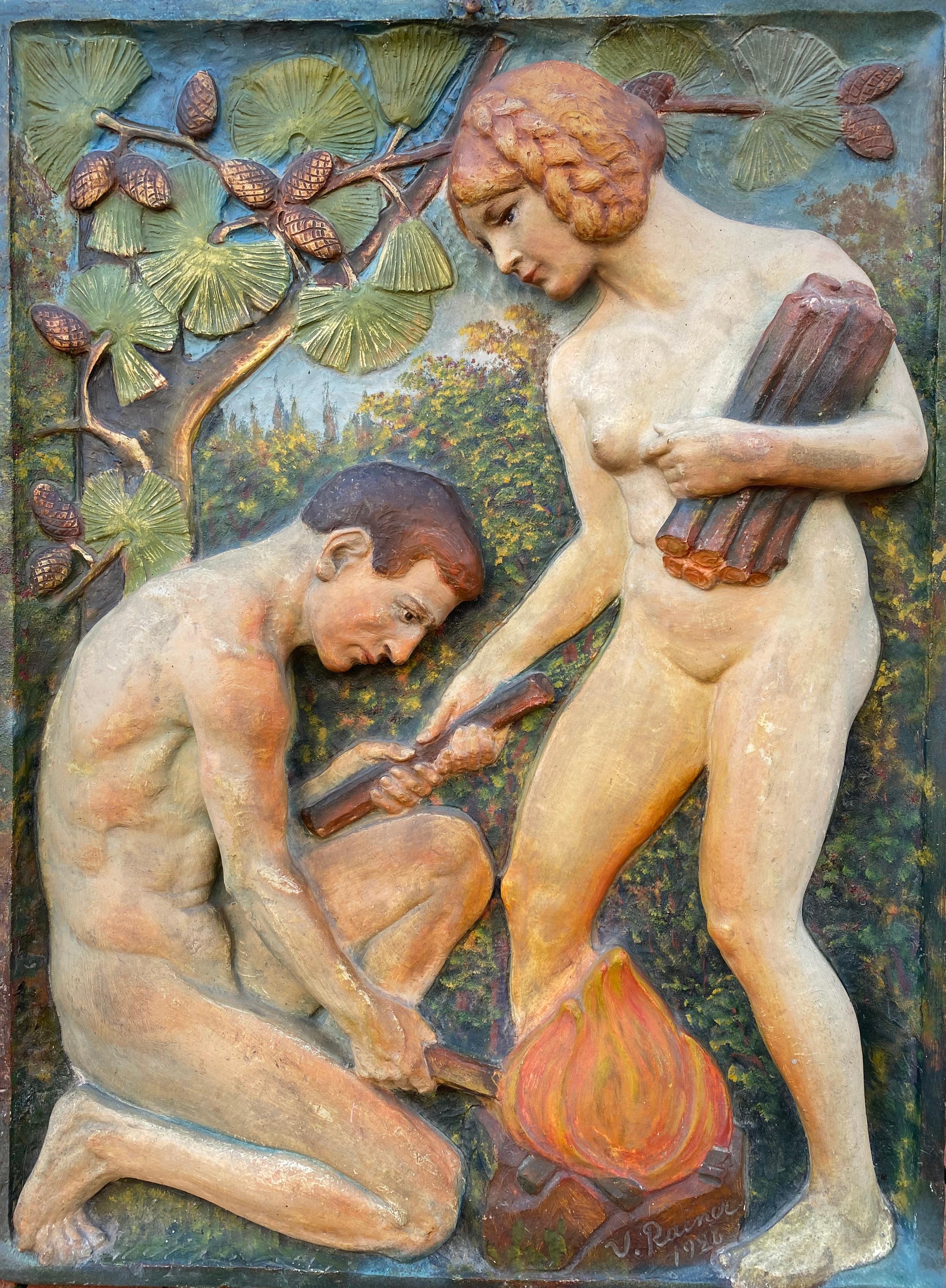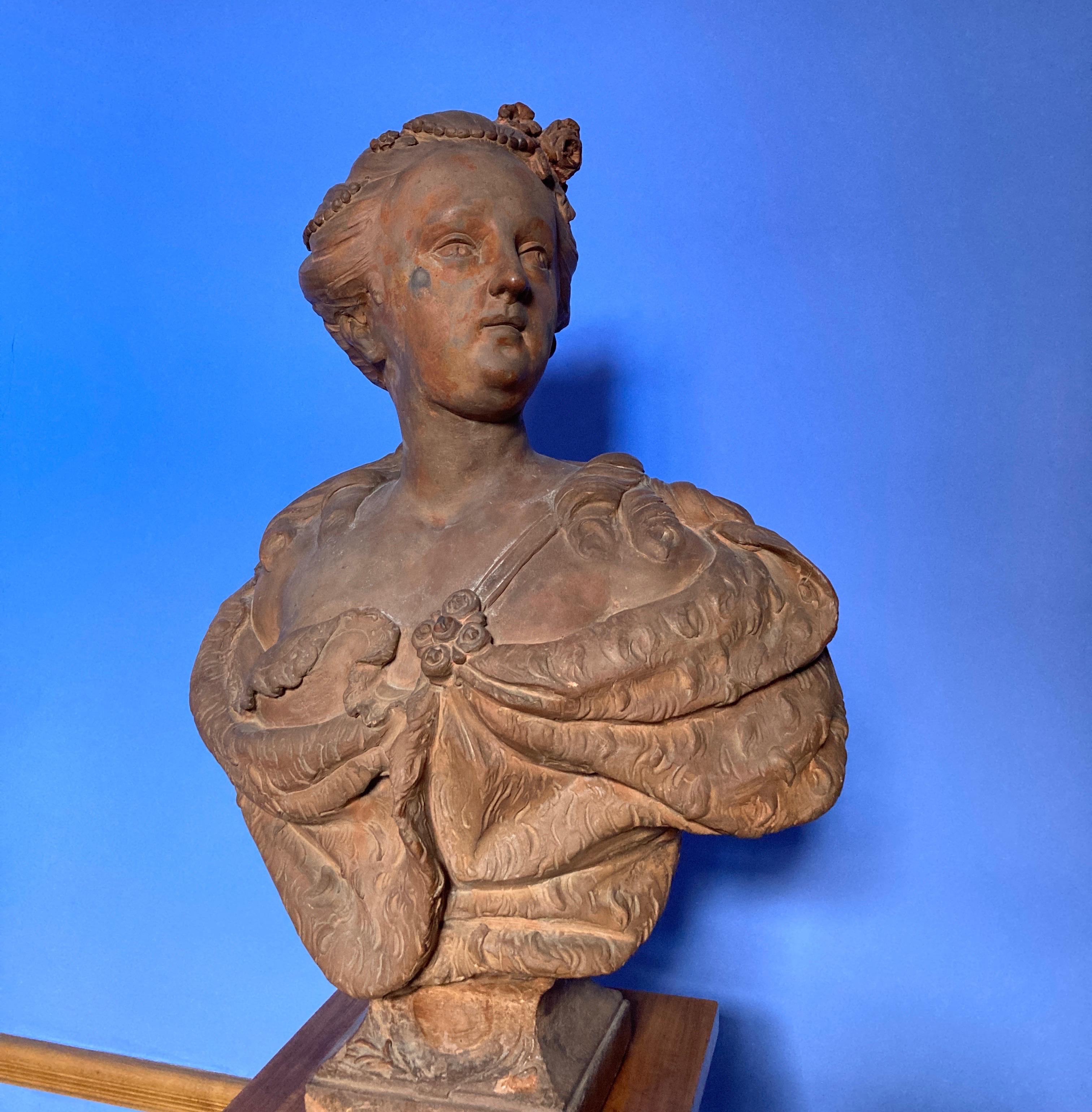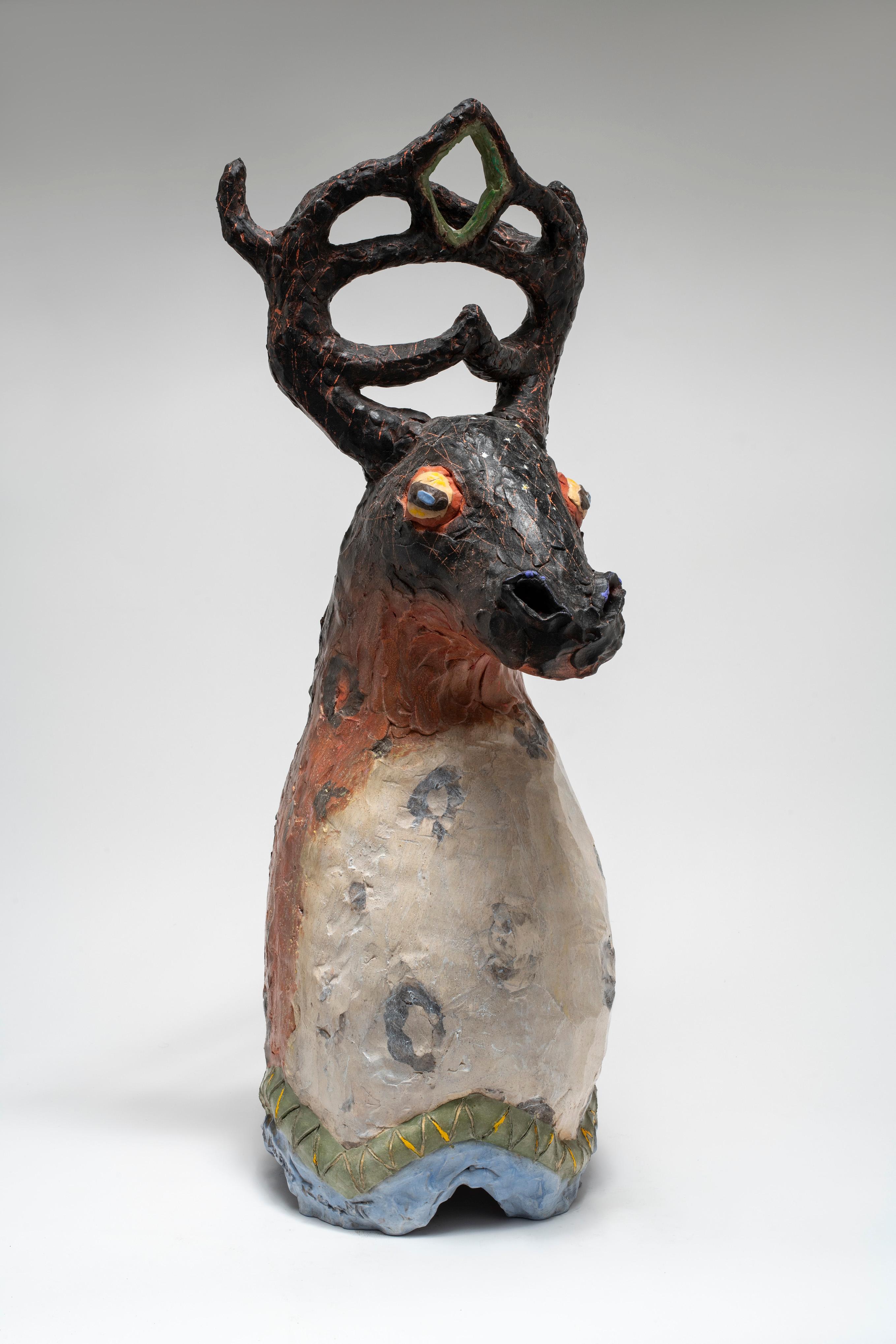Items Similar to Pre-Columbian Colima Shaman terracotta figure vessel Mexican sculpture
Video Loading
Want more images or videos?
Request additional images or videos from the seller
1 of 15
UnknownPre-Columbian Colima Shaman terracotta figure vessel Mexican sculpture ca. 300 BCE - 300 CE
ca. 300 BCE - 300 CE
About the Item
Seated Shaman
Colima culture
Mexico
ca. 300 BCE - 300 CE
Pre-Columbian, West Mexico, Colima, ca. 300 BCE to 300 CE. A hollow-cast and highly-burnished terracotta hunchback shaman figural vessel.
Hunchbacks were considered sacred in Pre Columbian cultures and are often depicted as shamans or as assistants to royalty. The shaman holds an oval vessel and shakes a rattle in his lively role within a feasting ritual. Feasting was one of the four most important themes portrayed in West Mexican art, along with kinship, status, and power (Butterwick, Heritage of Power, 2005, p. 12). Feasting ceremonies were an integral part of a community that solidified economic and social interaction within and between villages, engaging all levels of the society.
It is suggested that the rattles were peyote buttons which would be integral to any shamanic activity surrounding a religious feast. The known intoxicating liquids included octli, or pulque from agave plants, or tesvino, maize beer (Butterwick, in Townsend, ed., Ancient West Mexico, 1998, p. 103). This figure also wears the insignia of rank with the shell projection on the forehead secured with the incised band wrapped carefully around the chin and head. The stylized head faces the bowl with a solemn, determined visage comprised of coffee bean eyes, a pronounced pointed nose, pursed lips, and sensitively contoured facial planes, all topped by a caplike headdress with a horn rising from the center. A very unusual element is the small nose ring. The most curious aspect is the specific abnormality of the figure's spine. His back exhibits a protrusion not unlike an animal's tail, suggesting that the figure was based on a specific shaman. Overall, the graceful lines and studied proportions place this example among those of the highest distinction.
Colima, located on Mexico's southwestern coast, was during this time part of the shaft tomb culture, along with neighbors to the north in Jalisco and Nayarit. In this culture, the deceased were buried down shafts - ranging from 3 to 20 meters deep - that were dug vertically or near vertically through the volcanic tuff known as "tepetate" that makes up the geology of the region. The base of the shaft would open into one or more horizontal chambers with a low ceiling. These shafts were almost always dug beneath a dwelling, probably a family home, and seem to have been used as family mausoleums, housing the remains of many related individuals. Ornate vessels and finely modeled figures like this one were placed in the tombs in order to hold offerings and protect the soul of the deceased.
Condition: Thumb and bowl on left hand have broken off as one piece and have been reattached. Otherwise intact. Covered with nice burnishing marks.
All items legal to buy/sell under U.S. Statute covering cultural patrimony Code 2600, CHAPTER 14, and are guaranteed to be as described or your money back.
A Certificate of Authenticity will accompany all purchases
- Creation Year:ca. 300 BCE - 300 CE
- Dimensions:Height: 12 in (30.48 cm)Width: 12.25 in (31.12 cm)Depth: 8 in (20.32 cm)
- Medium:
- Period:
- Condition:
- Gallery Location:Wilton Manors, FL
- Reference Number:1stDibs: LU24525339032
About the Seller
4.9
Platinum Seller
These expertly vetted sellers are 1stDibs' most experienced sellers and are rated highest by our customers.
Established in 2007
1stDibs seller since 2015
330 sales on 1stDibs
Typical response time: 1 hour
- ShippingRetrieving quote...Ships From: Wilton Manors, FL
- Return PolicyA return for this item may be initiated within 7 days of delivery.
More From This SellerView All
- Veracruz Mexico Pre-Columbian ceramic Warrior figure sculptureLocated in Wilton Manors, FLFigure of a Chanting Warrior Ceramic with bitumen highlights 300-600 CE (Classic Period) Mexico, Veracruz, possibly Nopiloa Veracruz Culture Pre-Columbian, Mexico, Vera Cruz culture...Category
15th Century and Earlier Figurative Sculptures
MaterialsCeramic
- Abstract FigureBy Raul DiazLocated in Wilton Manors, FLRaul Diaz (Argentina, b.1950). Abstract Figure, ca. 1970s. Canved Walnut. Measures 17 inches tall including wood base. Carved signature in lower region. Excellent condition. An ear...Category
1970s Abstract Expressionist Abstract Sculptures
MaterialsWalnut
- African BoyLocated in Wilton Manors, FLBeautiful ca. 1970s sculpture depicting African boy. Carved and stained hardwood. Some splits in wood consistent with age, not damage. Signed indistinctly on back of platform.Category
1970s Realist Figurative Sculptures
MaterialsWood
- Late 15th-century Old Master Burgundian Netherlands carved walnut figureLocated in Wilton Manors, FLBeautiful late 15th-century Burgundian Netherlandish portrait of a woman. Carved walnut. Original polychrome has been removed with traces at base and lower portions of figure. Minor ...Category
15th Century and Earlier Old Masters Figurative Sculptures
MaterialsWalnut
- Walking FigureBy Herbert KallemLocated in Wilton Manors, FLMaterials: bronze, possibly another metal, stone (base) Dimensions (H, W, D): 16.25"h, 5"w, 4.5"d (base comprises approx. 1.25" of height) Additional Information: Provenance: Collect...Category
Mid-20th Century Abstract Expressionist Abstract Sculptures
MaterialsMetal
- Reaching (bronze hand)Located in Wilton Manors, FLReaching, ca. 1980. Cast bronze. Signed in lower region on wrist. A rare example from the artist's later period influenced by figurative abstraction with expressionist tendencies. James Edward Lewis (August 4, 1923 – August 9, 1997) was an African-American artist, art collector, professor, and curator in the city of Baltimore. He is best known for his role as the leading force for the creation of the James E. Lewis Museum of Art, an institution of the HBCU Morgan State University. His work as the chairman of the Morgan Art Department from 1950 to 1986 allowed for the museum to amass a large collection of more than 3,000 works, predominantly of African and African diasporan art.[1] In addition, he is also well known for his role as an interdisciplinary artist, primarily focused on sculpture, though also having notable examples of lithography and illustration. His artistic style throughout the years has developed from an earlier focus on African-American history and historical figures, for which he is most notable as an artist, to a more contemporary style of African-inspired abstract expressionism. Early and personal life James E. Lewis was born in rural Phenix, Virginia on August 4, 1923 to James T. Lewis and Pearline (Pearlean) Harvey.[5] Lewis' parents were both sharecroppers. Shortly after his birth, his father moved to Baltimore for increased job opportunity; James E. was subsequently raised by his mother until the family was reunited in 1925. They lived for a short time with distant relatives until moving to a four-bedroom house on 1024 North Durham Street in East Baltimore, a predominantly African-American lower-class neighborhood close to Johns Hopkins Hospital. Lewis' primary school, PS 101, was the only public school in East Baltimore that served black children. Lewis grew up in a church-going family, his parents both active members of the Faith Baptist Church, devoting the entirety of their Sundays to church activities. His parents worked a variety of different jobs throughout his youth:[6] his father working as a stevedore for a shipping company, a mechanic, a custodian, a mailroom handler,[6] and an elevator operator.] His mother worked as both a clerk at a drugstore[7] and a laundress for a private family.[4] Lewis' primary exposure to the arts came from Dr. Leon Winslow, a faculty member at PS 101 who Lewis saw as "providing encouragement and art materials to those who wanted and needed it." In fifth grade, Lewis transferred to PS 102. Here, he was able to receive specialized Art Education in Ms. William's class under the guidance of Winslow. He was considered a standout pupil at PS 102 as a result of his introduction to the connection between the arts and the other studies. His time spent in Ms. Pauline Wharton's class allowed for him to experiment with singing, to which he was considered a talented singer. His involvement in this class challenged his earlier belief that singing was not a masculine artistic pursuit. He was able to study both European classics and negro spirituals, which was one of his earliest introductions to arts specific to American black culture. Under Ms. Wharton's direction, he was also involved in many different musical performances,[6] including some works of the Works Progress Administration's Federal Theatre Project.[8] Lewis attended Paul Laurence Dunbar High School, where his love of the arts was heightened through his industrial art class with Lee Davis...Category
Mid-20th Century Abstract Expressionist Abstract Sculptures
MaterialsBronze
You May Also Like
- Horse - Taal Mayon, Sculpture by Ben GonzalesBy Ben A. GonzalesLocated in Long Island City, NYTitle: Horse - Taal Mayon Year: 1981 Medium: Terra Cotta Sculpture, signed and dated Size: 20.5 in. x 23 in. x 6 in. (52.07 cm x 58.42 cm x 15.24 cm)Category
1980s Modern Figurative Sculptures
MaterialsTerracotta
- “Mother and Children”Located in Southampton, NYMid century modern original terracotta sculpture by the Hungarian artist, Anna Berkovits of a young woman with her two children. Circa 1955. Signed in the inside of the base. Condition is excellent. Parts of the sculpture have been deliberately not been glazed by the artist. Her work rarely becomes available. Provenance: Sarasota, Florida estate. Anna Berkovits was born in Hungary in 1911 and lived and worked in Budapest. She trained under the art teacher Almos Jaschik in Budapest. Later she was trained in ceramics by the artist Gador Istvan...Category
1950s Modern Figurative Sculptures
MaterialsTerracotta
- Untitled, sculpture, terracotta, African artLocated in Milano, ITReinata Sadimba Senza Titolo Ceramic sculpture cm 47 x 28 x 26 Signed work in drypoint. Artwork accompanied by certificate of authenticity issued by the Foundation Sarenco, Salo. Bo...Category
Early 2000s Contemporary Figurative Sculptures
MaterialsTerracotta
- “Adam and Eve”Located in Southampton, NYVery rare Art Deco three dimensional terracotta sculpture of Adam and Eve by the Austrian artist, Virgil Rainer. Hand painted by the artist. Signed bott...Category
1920s Art Deco Figurative Sculptures
MaterialsTerracotta, Plaster
- Bust of a Lady, prob Queen Elisabeth Petrowna, Terracotta Sculpture, Baroque ArtLocated in Greven, DEBust of a Lady, thought to be Elisabeth Petrowna, also known as Elisabeth of Russia Depicted before she was crowned Terracotta Bust Elizabeth Petrovna (Russian: Елизаве́та (29 Decem...Category
18th Century Baroque Figurative Sculptures
MaterialsTerracotta
- From the forest, from the sea Nicolas Kennett 21st Century art terracotta stagLocated in Paris, FRUnique terracotta sculpture Signed on the baseCategory
2010s Contemporary Figurative Sculptures
MaterialsTerracotta
Recently Viewed
View AllMore Ways To Browse
Ces A
Antique Figural Sculpture
Antique Figure Sculpture
Antique Sculptures Black
Small Antique Sculpture
Antique Face Sculpture
Money Sculpture
Figural Vessel
Antique Terracotta Sculptures
Ancient Terracotta
Oval Vessel
Seated Figure Sculpture
Pre Columbian
3 Faces Sculpture
Antique Mexican Art
Ancient Head Sculpture
Bowl Hand Sculpture
Terracotta Figural





